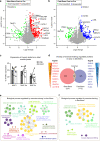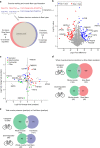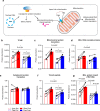Deep muscle-proteomic analysis of freeze-dried human muscle biopsies reveals fiber type-specific adaptations to exercise training
- PMID: 33436631
- PMCID: PMC7803955
- DOI: 10.1038/s41467-020-20556-8
Deep muscle-proteomic analysis of freeze-dried human muscle biopsies reveals fiber type-specific adaptations to exercise training
Erratum in
-
Author Correction: Deep muscle-proteomic analysis of freeze-dried human muscle biopsies reveals fiber type-specific adaptations to exercise training.Nat Commun. 2021 Mar 5;12(1):1600. doi: 10.1038/s41467-021-22015-4. Nat Commun. 2021. PMID: 33674588 Free PMC article. No abstract available.
Abstract
Skeletal muscle conveys several of the health-promoting effects of exercise; yet the underlying mechanisms are not fully elucidated. Studying skeletal muscle is challenging due to its different fiber types and the presence of non-muscle cells. This can be circumvented by isolation of single muscle fibers. Here, we develop a workflow enabling proteomics analysis of pools of isolated muscle fibers from freeze-dried human muscle biopsies. We identify more than 4000 proteins in slow- and fast-twitch muscle fibers. Exercise training alters expression of 237 and 172 proteins in slow- and fast-twitch muscle fibers, respectively. Interestingly, expression levels of secreted proteins and proteins involved in transcription, mitochondrial metabolism, Ca2+ signaling, and fat and glucose metabolism adapts to training in a fiber type-specific manner. Our data provide a resource to elucidate molecular mechanisms underlying muscle function and health, and our workflow allows fiber type-specific proteomic analyses of snap-frozen non-embedded human muscle biopsies.
Conflict of interest statement
The authors declare no competing interests.
Figures






Similar articles
-
Transcriptomic signatures of human single skeletal muscle fibers in response to high-intensity interval exercise.Am J Physiol Cell Physiol. 2024 Nov 1;327(5):C1249-C1262. doi: 10.1152/ajpcell.00299.2024. Epub 2024 Sep 24. Am J Physiol Cell Physiol. 2024. PMID: 39316684
-
Single Muscle Fiber Proteomics Reveals Distinct Protein Changes in Slow and Fast Fibers during Muscle Atrophy.J Proteome Res. 2018 Oct 5;17(10):3333-3347. doi: 10.1021/acs.jproteome.8b00093. Epub 2018 Sep 5. J Proteome Res. 2018. PMID: 30142977
-
Need for speed: Human fast-twitch mitochondria favor power over efficiency.Mol Metab. 2024 Jan;79:101854. doi: 10.1016/j.molmet.2023.101854. Epub 2023 Dec 15. Mol Metab. 2024. PMID: 38104652 Free PMC article.
-
Muscle mechanics: adaptations with exercise-training.Exerc Sport Sci Rev. 1996;24:427-73. Exerc Sport Sci Rev. 1996. PMID: 8744258 Review.
-
Fiber Type-Specific Adaptations to Exercise Training in Human Skeletal Muscle: Lessons From Proteome Analyses and Future Directions.Scand J Med Sci Sports. 2025 May;35(5):e70059. doi: 10.1111/sms.70059. Scand J Med Sci Sports. 2025. PMID: 40281372 Free PMC article. Review.
Cited by
-
Effect of Pelvic Floor Workout on Pelvic Floor Muscle Function Recovery of Postpartum Women: Protocol for a Randomized Controlled Trial.Int J Environ Res Public Health. 2022 Sep 4;19(17):11073. doi: 10.3390/ijerph191711073. Int J Environ Res Public Health. 2022. PMID: 36078788 Free PMC article.
-
Phosphoproteomic analysis identifies differentially expressed phosphorylation sites that affect muscle fiber type in pigs.Front Nutr. 2022 Dec 22;9:1006739. doi: 10.3389/fnut.2022.1006739. eCollection 2022. Front Nutr. 2022. PMID: 36618708 Free PMC article.
-
Complexity of skeletal muscle degeneration: multi-systems pathophysiology and organ crosstalk in dystrophinopathy.Pflugers Arch. 2021 Dec;473(12):1813-1839. doi: 10.1007/s00424-021-02623-1. Epub 2021 Sep 22. Pflugers Arch. 2021. PMID: 34553265 Free PMC article. Review.
-
Human skeletal muscle fiber heterogeneity beyond myosin heavy chains.Nat Commun. 2025 Feb 19;16(1):1764. doi: 10.1038/s41467-025-56896-6. Nat Commun. 2025. PMID: 39971958 Free PMC article.
-
Current cutting-edge omics techniques on musculoskeletal tissues and diseases.Bone Res. 2025 Jun 9;13(1):59. doi: 10.1038/s41413-025-00442-z. Bone Res. 2025. PMID: 40484858 Free PMC article. Review.
References
-
- Saltin B, et al. Physical training and glucose tolerance in middle-aged men with chemical diabetes. Diabetes. 1979;28:30–32. - PubMed
-
- Dela F, et al. Insulin-stimulated muscle glucose clearance in patients with NIDDM: effects of one-legged physical training. Diabetes. 1995;44:1010–1020. - PubMed
-
- Schiaffino S, Reggiani C. Fiber types in mammalian skeletal muscles. Physiol. Rev. 2011;91:1447–1531. - PubMed
Publication types
MeSH terms
Substances
LinkOut - more resources
Full Text Sources
Other Literature Sources
Medical
Molecular Biology Databases
Miscellaneous

